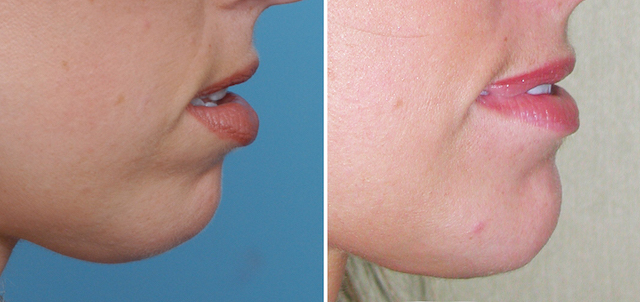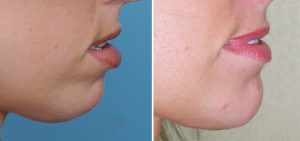Background: Chin deficiencies are typically described by the relationship of the most projecting part of the chin to the lower lip in the profile view. While this is a good aesthetic proportion to use, chin deficiencies may be associated with other physical findings as well. As chin deficiencies become greater soft tissue issues can develop with an inability of the lower lip to passively contact the upper lip and the mentalis muscle straining to do so. (lip incompetence and mentalis muscle strain)
Because lower lip incompetence and mentalis muscle dysfunction are more commonly associated with on overall lower jaw deficiency (and Class II bite relationship), the traditional treatment is skeletal. Either a sliding genioplasty for the chin or moving the entire lower jaw forward (sagittal split ramus osteotomy) are effective treatments for lower lip incompletence as the bone movement carries the soft tissue with it forward.
While these lower jaw and chin bone movements work, an interesting question is whether a chin implant could have the same effect. In theory it could be as the release of the soft tissue chin pad and its forward displacement by the implant should have a similar effect.
Case Study: This young female was to undergo a combined rhinoplasty and chin augmentation. It was elected for her chin augmentation to undergo a submental chin implant placement.

Implant augmentation of the chin can be effective for correcting both aesthetic and functional issues of the soft tissue chin pad and lower lip. In women using a more central chin implant style will avoid making it too wide in the frontal view.
Case Highlights:
1) Lip incompetence and mentalis muscle hyperactivity are not uncommon symptoms of a chin deficiency as part of a greater lower jaw underdevelopment.
2) Lower jaw advancement or sliding genioplasty are believed to be the most effective strategy for lower lip incompletence.,
3) Chin implant augmentation can also be an effective treatment for the soft tissue symptoms of lower facial skeletal deficiency.
Dr. Barry Eppley
Indianapolis, Indiana




